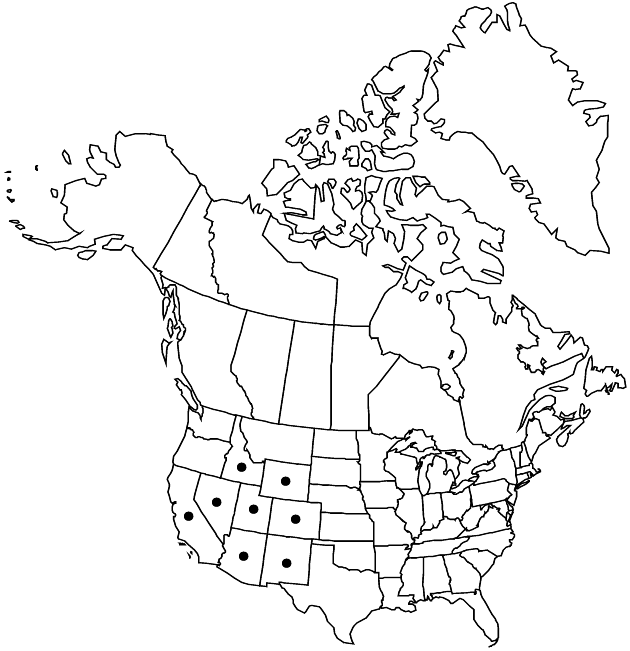Difference between revisions of "Erigeron concinnus"
Fl. N. Amer. 2: 174. 1841.
FNA>Volume Importer |
imported>Volume Importer |
||
| Line 8: | Line 8: | ||
}} | }} | ||
|common_names=Navajo fleabane | |common_names=Navajo fleabane | ||
| + | |special_status={{Treatment/ID/Special_status | ||
| + | |code=F | ||
| + | |label=Illustrated | ||
| + | }}{{Treatment/ID/Special_status | ||
| + | |code=E | ||
| + | |label=Endemic | ||
| + | }} | ||
|basionyms={{Treatment/ID/Basionym | |basionyms={{Treatment/ID/Basionym | ||
|name=Distasis concinna | |name=Distasis concinna | ||
| Line 30: | Line 37: | ||
-->{{Treatment/Body | -->{{Treatment/Body | ||
| − | |distribution= | + | |distribution=Ariz.;Calif.;Colo.;Idaho;N.Mex.;Nev.;Utah;Wyo. |
|discussion=<p>Varieties 3 (3 in the flora).</p><!-- | |discussion=<p>Varieties 3 (3 in the flora).</p><!-- | ||
--><p><i>Erigeron concinnus</i> has been treated within <i>E. pumilus</i>; G. L. Nesom (1983b) found that these species approach each other closely in geographic range without intergradation.</p> | --><p><i>Erigeron concinnus</i> has been treated within <i>E. pumilus</i>; G. L. Nesom (1983b) found that these species approach each other closely in geographic range without intergradation.</p> | ||
| Line 72: | Line 79: | ||
|basionyms=Distasis concinna | |basionyms=Distasis concinna | ||
|family=Asteraceae | |family=Asteraceae | ||
| − | |distribution= | + | |distribution=Ariz.;Calif.;Colo.;Idaho;N.Mex.;Nev.;Utah;Wyo. |
|reference=nesom1983b | |reference=nesom1983b | ||
|publication title=Fl. N. Amer. | |publication title=Fl. N. Amer. | ||
|publication year=1841 | |publication year=1841 | ||
| − | |special status= | + | |special status=Illustrated;Endemic |
| − | |source xml=https:// | + | |source xml=https://bibilujan@bitbucket.org/aafc-mbb/fna-data-curation.git/src/bb6b7e3a7de7d3b7888a1ad48c7fd8f5c722d8d6/coarse_grained_fna_xml/V19-20-21/V20_604.xml |
|tribe=Asteraceae tribe Astereae | |tribe=Asteraceae tribe Astereae | ||
|genus=Erigeron | |genus=Erigeron | ||
Revision as of 20:50, 27 May 2020
Perennials, 4–25(–50) cm; taprooted, caudices simple or branched, branches sometimes rhizomelike. Stems ascending to erect, sparsely to densely hispido-pilose to glabrate, minutely glandular. Leaves mostly basal (usually persistent) or basal and cauline (petioles prominently ciliate, hairs spreading, thick-based); blades narrowly oblanceolate to linear-oblong, 10–50(–80) × 1–4 mm, margins entire, usually ciliate, faces usually hirsute to hirsuto-villous, sometimes substrigose to glabrate, eglandular; cauline unreduced or gradually reduced distally. Heads 1–5. Involucres 4–7 × 7–12(–15) mm. Phyllaries in 2–4 series (midvein region orange or yellowish), hirsute to hirsuto-villous, ± minutely glandular. Ray florets 50–100(–125); corollas white to pink or blue, 6–15 mm, laminae reflexing. Disc corollas 3–5 mm (throats indurate and inflated, hirsuto-strigose, hairs biseriate, sharply pointed). Cypselae 1.2–1.8 mm, 2-nerved, faces sparsely strigoso-hirsute; pappi: outer of scales (0.2–0.5 mm), inner of (7–)10–14(–15) bristles.
Distribution

Ariz., Calif., Colo., Idaho, N.Mex., Nev., Utah, Wyo.
Discussion
Varieties 3 (3 in the flora).
Erigeron concinnus has been treated within E. pumilus; G. L. Nesom (1983b) found that these species approach each other closely in geographic range without intergradation.
Selected References
Lower Taxa
Key
| 1 | Heads 1; stems ± scapiform | Erigeron concinnus var. condensatus |
| 1 | Heads (1–)2–3(–5, rarely –50); stems leafy (at least proximal 1/2) | > 2 |
| 2 | Stems densely piloso-hispid | Erigeron concinnus var. concinnus |
| 2 | Stems glabrous or sparsely hirsute or piloso-hirsute (hairs sometimes ascending-appressed near heads) | Erigeron concinnus var. subglaber |